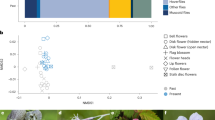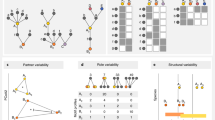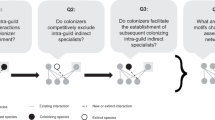Abstract
Despite clear evidence that some pollinator populations are declining, our ability to predict pollinator communities prone to collapse or species at risk of local extinction is remarkably poor. Here, we develop a model grounded in the structuralist approach that allows us to draw sound predictions regarding the temporal persistence of species in mutualistic networks. Using high-resolution data from a six-year study following 12 independent plant–pollinator communities, we confirm that pollinator species with more persistent populations in the field are theoretically predicted to tolerate a larger range of environmental changes. Persistent communities are not necessarily more diverse, but are generally located in larger habitat patches, and present a distinctive combination of generalist and specialist species resulting in a more nested structure, as predicted by previous theoretical work. Hence, pollinator interactions directly inform about their ability to persist, opening the door to use theoretically informed models to predict species’ fate within the ongoing global change.
This is a preview of subscription content, access via your institution
Access options
Access Nature and 54 other Nature Portfolio journals
Get Nature+, our best-value online-access subscription
$29.99 / 30 days
cancel any time
Subscribe to this journal
Receive 12 digital issues and online access to articles
$119.00 per year
only $9.92 per issue
Buy this article
- Purchase on Springer Link
- Instant access to full article PDF
Prices may be subject to local taxes which are calculated during checkout



Similar content being viewed by others
Data availability
A dataset of species interaction and abundances can be accessed via Zenodo52. Source data are provided with this paper.
Code availability
The code used in this study can be downloaded from Zenodo52.
References
Ollerton, J., Winfree, R. & Tarrant, S. How many flowering plants are pollinated by animals? Oikos 120, 321–326 (2011).
Potts, S. G. et al. Safeguarding pollinators and their values to human well-being. Nature 540, 220–229 (2016).
Potts, S. G. et al. Global pollinator declines: trends, impacts and drivers. Trends Ecol. Evol. 25, 345–353 (2010).
Winfree, R., Bartomeus, I. & Cariveau, D. P. Native pollinators in anthropogenic habitats. Annu. Rev. Ecol. Evol. Syst. 42, 1–22 (2011).
Dicks, L. V. et al. A global-scale expert assessment of drivers and risks associated with pollinator decline. Nat. Ecol. Evol. 5, 1453–1461 (2021).
The Methodological Assessment Report on Scenarios and Models of Biodiversity and Ecosystem Services (IPBES, 2016).
Dietze, M. & Lynch, H. Forecasting a bright future for ecology. Front. Ecol. Environ. 17, 3 (2019).
Grimm, V., Schmidt, E. & Wissel, C. On the application of stability concepts in ecology. Ecol. Modell. 63, 143–161 (1992).
Ives, A. R. & Carpenter, S. R. Stability and diversity of ecosystems. Science 317, 58–62 (2007).
Domínguez-García, V. et al. Advancing our understanding of ecological stability. Ecol. Lett. 22, 1349–1356 (2019).
Donohue, I. et al. On the dimensionality of ecological stability. Ecol. Lett. 16, 421–429 (2013).
Meerbeek, K. V., Jucker, T. & Svenning, J.-C. Unifying the concepts of stability and resilience in ecology. J. Ecol. 109, 3114–3132 (2021).
Domínguez-García, V., Dakos, V. & Kéfi, S. Unveiling dimensions of stability in complex ecological networks. Proc. Natl Acad. Sci. USA 116, 25714–25720 (2019).
Rohr, R. P., Saavedra, S. & Bascompte, J. On the structural stability of mutualistic systems. Science 345, 1253497 (2014).
Solé, R. V. & Valls, J. On structural stability and chaos in biological systems. J. Theor. Biol. 155, 87–102 (1992).
Medeiros, L. P., Boege, K., del Val, E., Zaldívar-Riverón, A. & Saavedra, S. Observed ecological communities are formed by species combinations that are among the most likely to persist under changing environments. Am. Nat. 197, E17–E29 (2021).
Godoy, O., Bartomeus, I., Rohr, R. P. & Saavedra, S. Towards the integration of niche and network theories. Trends Ecol. Evol. 33, 287–300 (2018).
Song, C., Rohr, R. P. & Saavedra, S. A guideline to study the feasibility domain of multi-trophic and changing ecological communities. J. Theor. Biol. 450, 30–36 (2018).
Song, C., Rohr, R. P. & Saavedra, S. Why are some plant–pollinator networks more nested than others? J. Anim. Ecol. 86, 1417–1424 (2017).
Saavedra, S., Medeiros, L. P. & AlAdwani, M. Structural forecasting of species persistence under changing environments. Ecol. Lett. 23, 1511–1521 (2020).
Tabi, A., Petchey, O. L. & Pennekamp, F. Warming reduces the effects of enrichment on stability and functioning across levels of organisation in an aquatic microbial ecosystem. Ecol. Lett. 22, 1061–1071 (2019).
Bartomeus, I., Saavedra, S., Rohr, R. P. & Godoy, O. Experimental evidence of the importance of multitrophic structure for species persistence. Proc. Natl Acad. Sci. USA 118, e2023872118 (2021).
Allen-Perkins, A., García-Callejas, D., Bartomeus, I. & Godoy, O. Structural asymmetry in biotic interactions as a tool to understand and predict ecological persistence. Ecol. Lett. 26, 1647–1662 (2023).
Chacoff, N. P. et al. Evaluating sampling completeness in a desert plant–pollinator network. J. Anim. Ecol. 81, 190–200 (2011).
Ponisio, L. C., Gaiarsa, M. P. & Kremen, C. Opportunistic attachment assembles plant–pollinator networks. Ecol. Lett. 20, 1261–1272 (2017).
Peralta, G. et al. Trait matching and phenological overlap increase the spatio-temporal stability and functionality of plant–pollinator interactions. Ecol. Lett. 23, 1107–1116 (2020).
Gaiarsa, M. P., Kremen, C. & Ponisio, L. C. Pollinator interaction flexibility across scales affects patch colonization and occupancy. Nat. Ecol. Evol. 5, 787–793 (2021).
Bastolla, U. et al. The architecture of mutualistic networks minimizes competition and increases biodiversity. Nature 458, 1018–1020 (2009).
Saavedra, S., Rohr, R. P., Olesen, J. M. & Bascompte, J. Nested species interactions promote feasibility over stability during the assembly of a pollinator community. Ecol. Evol. 6, 997–1007 (2016).
Blanchard, G. & Munoz, F. Revisiting extinction debt through the lens of multitrophic networks and meta-ecosystems. Oikos (2022).
Gravel, D., Guichard, F., Loreau, M. & Mouquet, N. Source and sink dynamics in meta-ecosystems. Ecology 91, 2172–2184 (2010).
García-Callejas, D., Bartomeus, I. & Godoy, O. The spatial configuration of biotic interactions shapes coexistence-area relationships in an annual plant community. Nat. Commun. 12, 6192 (2021).
Vázquez, D. P. et al. Species abundance and asymmetric interaction strength in ecological networks. Oikos 116, 1120–1127 (2007).
Olito, C. & Fox, J. W. Species traits and abundances predict metrics of plant–pollinator network structure, but not pairwise interactions. Oikos 124, 428–436 (2014).
Taylor, S. J. S., Evans, B. S., White, E. P. & Hurlbert, A. H. The prevalence and impact of transient species in ecological communities. Ecology 99, 1825–1835 (2018).
Clark, T. & Luis, A. D. Nonlinear population dynamics are ubiquitous in animals. Nat. Ecol. Evol. 4, 75–81 (2020).
Tilman, D., Reich, P. B. & Knops, J. M. H. Biodiversity and ecosystem stability in a decade-long grassland experiment. Nature 441, 629–632 (2006).
Tilman, D. Biodiversity: population versus ecosystem stability. Ecology 77, 350–363 (1995).
Gross, K. et al. Species richness and the temporal stability of biomass production: a new analysis of recent biodiversity experiments. Am. Nat. 183, 1–12 (2014).
Lázaro, A., Gómez-Martínez, C., González-Estévez, M. A. & Hidalgo, M. Portfolio effect and asynchrony as drivers of stability in plant–pollinator communities along a gradient of landscape heterogeneity. Ecography 3, e06112 (2022).
Yachi, S. & Loreau, M. Biodiversity and ecosystem productivity in a fluctuating environment: the insurance hypothesis. Proc. Natl Acad. Sci. USA 96, 1463–1468 (1999).
Potts, S. et al. Proposal for an EU Pollinator Monitoring Scheme (Publications Office of the European Union, 2020).
Woodard, S. H. et al. Towards a U.S. national program for monitoring native bees. Biol. Conserv. 252, 108821 (2020).
Bascompte, J., Jordano, P., Melian, C. J. & Olesen, J. M. The nested assembly of plant–animal mutualistic networks. Proc. Natl Acad. Sci. USA 100, 9383–9387 (2003).
Kendall, L. K. et al. The potential and realized foraging movements of bees are differentially determined by body size and sociality. Ecology 103, e3809 (2022).
Reckling, M. et al. Methods of yield stability analysis in long-term field experiments. A review. Agron. Sustain. Dev. 41, 27 (2021).
Hsieh, T. C., Ma, K. H. & Chao, A. iNEXT: an R package for rarefaction and extrapolation of species diversity (Hill numbers). Methods Ecol. Evol. 7, 1451–1456 (2016).
Cenci, S. & Saavedra, S. Structural stability of nonlinear population dynamics. Phys. Rev. E 97, 012401 (2018).
García-Callejas, D. et al. Non-random interactions within and across guilds shape the potential to coexist in multi-trophic ecological communities. Ecol. Lett. 26, 831–842 (2023).
Jonhson, S., Domínguez-García, V. & Muñoz, M. A. Factors determining nestedness in complex networks. PLoS ONE 8, e74025 (2013).
Dormann, C. F., Gruber, B. & Fruend, J. Introducing the bipartite package: analysing ecological networks. R News 8, 8–11 (2008).
Domínguez-García, V., Molina, F. P., Godoy, O. & Bartomeus, I. Data and code corresponding to the article “Interaction network structure explains species temporal persistence in empirical plant–pollinator communities”. Zenodo https://doi.org/10.5281/zenodo.10083504 (2023).
Acknowledgements
We thank taxonomists L. O. Aguado and T. Wood. This research was funded through the 2017–2018 Belmont Forum and BiodivERsA joint call for research proposals, under the BiodivScen ERA-Net COFUND programme, and with the funding organisations AEI, NWO, ECCyT and NSF to I.B. and V.D.-G. This project has received funding from the European Union’s Horizon 2021 research and innovation programme under the Marie Skłodowska-Curie grant agreement No 101064340 to V.D.-G., TASTE Project (PID2021-127607OB-I00) to O.G, I.B. and V.D.-G., and BeeFUN project (PCIG 14-GA-2013-631653) to I.B.
Author information
Authors and Affiliations
Contributions
V.D.-G., O.G. and I.B. designed research; F.P.M. and I.B. did fieldwork and F.P.M. identified species; V.D.-G. developed code and analysed data; V.D.-G. and I.B. performed research; and V.D.-G., O.G. and I.B. wrote the paper.
Corresponding author
Ethics declarations
Competing interests
The authors declare no competing interests.
Peer review
Peer review information
Nature Ecology & Evolution thanks Nico Bluethgen, Marília Palumbo Gaiarsa and the other, anonymous, reviewer(s) for their contribution to the peer review of this work. Peer reviewer reports are available.
Additional information
Publisher’s note Springer Nature remains neutral with regard to jurisdictional claims in published maps and institutional affiliations.
Supplementary information
Supplementary Information
Supplementary Figs. 1–17, Supplementary results and methods text, and Supplementary Tables 1 and 2.
Source data
Source Data Figs. 2 and 3
Dataset of plant–pollinator interactions at each site and dataset of pollinators’ yearly abundance at each site.
Rights and permissions
Springer Nature or its licensor (e.g. a society or other partner) holds exclusive rights to this article under a publishing agreement with the author(s) or other rightsholder(s); author self-archiving of the accepted manuscript version of this article is solely governed by the terms of such publishing agreement and applicable law.
About this article
Cite this article
Domínguez-Garcia, V., Molina, F.P., Godoy, O. et al. Interaction network structure explains species’ temporal persistence in empirical plant–pollinator communities. Nat Ecol Evol 8, 423–429 (2024). https://doi.org/10.1038/s41559-023-02314-3
Received:
Accepted:
Published:
Issue Date:
DOI: https://doi.org/10.1038/s41559-023-02314-3



